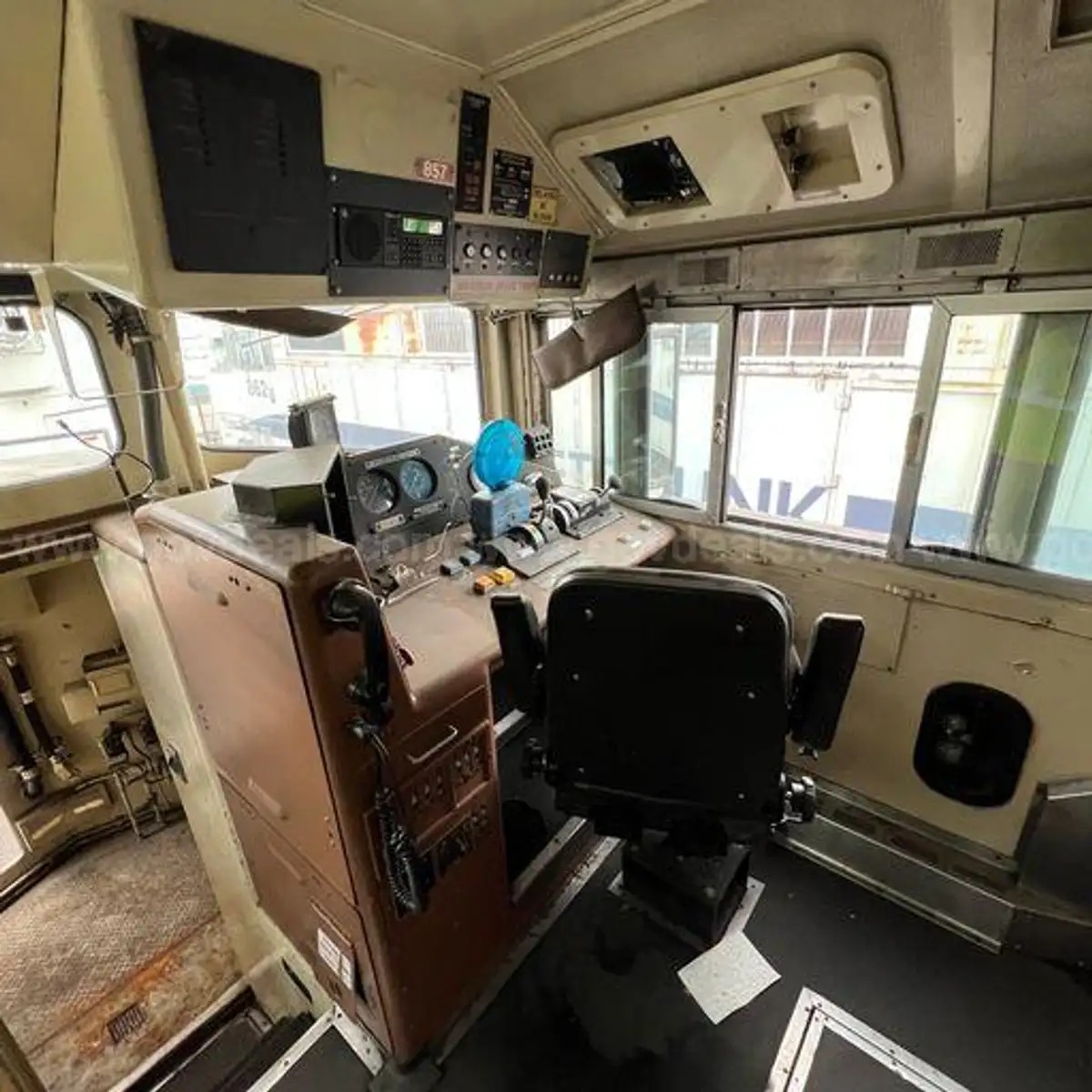If you’ve ever wanted to buy something a bit daft, a bit nonsensical, I recommend taking a stroll down the pages of GovDeals. Need a helicopter, a backhoe, and a police car all at the same time? You can find a government entity selling each on GovDeals. The wonderful auction platform is even where I found my beloved transit bus. Right now, you can get something exponentially more chaotic from GovDeals. The Southern California Regional Rail Authority is selling a 1992 EMD F59PH locomotive, but it’s going to need some work before you can get it back on the rails again.
Sadly, my season of railfanning has, for the most part, come to an end. My favorite train museum, the Illinois Railway Museum, has put most of its toys away to prepare for the upcoming winter. I got to experience a couple of awesome events at the museum before this, which you may get to read about soon.
For now, I wait until next year to ride vintage rail equipment again. Thankfully, some of you are keeping me warm and fuzzy with trains to look at. Today, 57sweptside sent in this EMD F59PH and I can’t stop laughing. I mean, what would you even do with a decommissioned locomotive? Maybe an absurd tiny house?

Now, before I continue, I do want to point out that if you have the kind of cash to just buy a locomotive, there are sites for that. Sterling Rail is full of rail equipment for sale for you to drool over. Still, I can’t help but giggle that California’s Metrolink is auctioning this thing off at the same place you can currently buy any one of about 204 school buses currently for sale. It’s not common, but some governments do offload whole locomotives on GovDeals.
From A Former Division Of General Motors

The might of General Motors used to spread far and wide beyond the cars and trucks you see today. In decades past, General Motors had a dominating grasp of various segments of the bus industry, ownership of North American Aviation, and nearly controlled the market for locomotives. Seriously, in 1953, General Motors’ Electro-Motive Division (EMD) held an incredible 73 percent of America’s locomotive market. Second place was the American Locomotive Company (Alco), which wasn’t even close at a mere 15 percent. By the mid-1960s, General Motors lost some ground and General Electric moved into second place, but GM’s EMD still controlled 70 percent of the market.
EMD traces its roots back to 1922 when Harold L. Hamilton and Paul Turner founded the Electro-Motive Engineering Corporation. The Ohio-based firm designed self-propelled passenger railcars that utilized Winton gasoline engines to generate power and General Electric motors for traction. As Assembly Magazine writes, the company’s name was quickly shortened to just the Electro-Motive Company and at the time, the firm didn’t have its own factory.

Instead, its railcars were an assemblage of power from Winton and GE with construction farmed out to the St. Louis Car Co., Standard Steel Car Co., and other companies. EMC sold its first railcar in 1924 and it featured a six-cylinder prime mover that produced 175 HP. By 1925, EMC ramped up production, selling 27 railcars that year. Later, Winton gas engines got as high as 400 HP. During the 1920s, Winton also had stationary and marine diesel engines before beginning an experiment to develop a four-stroke diesel engine for rail applications.
General Motors was also interested in diesel engines. Vice President of General Motors Research Laboratories, Charles Kettering, believed in the future of diesel power. In 1928, Kettering joined forces with Winton to develop a two-stroke diesel. But Winton had struggles keeping up with demand and development, then eventually found itself for sale. The National Park Service summarizes how General Motors changed railroad history:

In 1930, General Motors Corporation, principally an automobile manufacturer, acquired the Electro Motive Corporation and the Winton Engine Company, the latter an established producer of diesel engines, and from this merger came a much smaller, much lighter diesel engine capable of producing many horsepower. This advanced diesel engine powered the Chevrolet exhibit at the Chicago World’s Fair in 1933. Ralph Budd of the Chicago, Burlington and Quincy Railroad saw it there and decided to use this type of engine for his railroad’s Pioneer Zephyr, a prototype of lightweight, stainless steel, streamlined fast passenger trains.
On May 26, 1934, the sleek, silver Pioneer Zephyr set off on the return from a trip to Denver to run 1,015.4 miles to Chicago in 13 hours, 4 minutes and 58 seconds, an average speed of 76.61 miles per hour, though in fact the three-car articulated train exceeded 100 miles per hour during the trip. About the same time, the Union Pacific fielded the similar but bright yellow City of Salina, while in 1935 the Atchison, Topeka & Santa Fe purchased from Electro-Motive Corporation a pair of diesels to power the Super Chief between Chicago and Los Angeles. Thus the 1930s ushered in not only the era of the streamlined “lightweight” passenger train, but the era of diesel- electric motive power for passenger trains as well.

In March 1935, General Motors Corporation began construction of a huge plant for erection of diesel electric locomotives at La Grange, Illinois, where the company would have the capability of building the locomotive carbody on a cast underframe. The locomotives would employ General Electric motors. The first La Grange product proved to be a 600-horsepower diesel-electric switcher with a cab at one end and exposed running boards on each side. It would more or less serve as a model for the most popular switch-engines for more than a decade. In 1937, an enlarged La Grange plant turned out the first E-Units, streamlined passenger locomotives with built-in cab and running boards along each side of the engines concealed in the carbody, a design that came to be called the “covered wagon” type, because cab and engine were totally enclosed. In 1939, Electro-Motive built the first similarly streamlined Model FT freight locomotive, consisting of an “A” unit with cab, and a “B” unit without, coupled together. Two such pair could be operated together as an “A-B-B-A” combination of four locomotives, all relying on a single crew in a single control cab.

The National Park Service continued that being able to operate multiple diesel-electric locomotives from a single cab only further cemented the type’s, and EMD’s, future. Linking steam engines together necessitated a crew to operate each locomotive. But diesel-electric? A single fireman and engineer could take command of eight to ten locomotives from the controls of just one cab. This saved on labor. A single fuel further saved on costs as well and diesel-electrics didn’t need to guzzle down water like a steamer.
General Motors’ part of EMD history lasted all the way to 2010, when EMD was sold to Caterpillar’s Progress Rail. By 2010, EMD, now called Electro-Motive Diesel, had fallen to a market share of just 30 percent in America.
This EMD F59PH

Now that we’ve established just how awesome EMD was in locomotives, let’s take a look at what you can get from the Southern California Regional Rail Authority.
Development on the F59PH started in about 1985 when GO Transit of Toronto approached EMD with a proposal to help the system update its fleet. GO Transit’s EMD GP40TC and EMD F40PH units were aging and it was time for an update. The transit system’s proposal was for EMD to modify a GP59 freight locomotive (below) to be a better fit for passenger service. The new locomotives would get an independent head-end power (HEP) generator (this provides power to the passenger cars) with a full-cowl carbody featuring a comfort cab.

The prime mover would carry over from the “Geep” as well. Under the covers sits an EMD 12-710 G3A, a V12 with each cylinder displacing 710 cubic inches (11.6 liters) on its own! Rated output was 3,000 HP, or the same as an outgoing EMD F40PH, but this was a different platform. For example, since the HEP alternator in some EMD F40PHs is not independent of the prime mover, the engine had to run at full speed (893 RPM), even at idle throttle, to generate energy for the passenger cars. The F59PH models wouldn’t have that quirk. HEP generation came from a 14.6 liter CAT 3406 inline-six diesel engine.
GO Transit’s EMD F59PH locomotives were put into service in 1988. California’s Metrolink would get its first units in 1992. Later, the F59PH would get developed into the F59PHI, a more streamlined locomotive with 3,200 HP plus an isolated cab to reduce vibration and noise.

Metrolink used these locomotives for years before selling some off and retiring others. This locomotive was deactivated back in 2020. Apparently, a government grant required Metrolink to disable the locomotive by cutting holes into the prime mover and HEP generator. You can see a box-cut into the HEP generator and a rather large chunk taken out of the prime mover.


So, if you ever want to use this guy as a locomotive again, you’ll probably at minimum need to buy another EMD 12-710 G3A. Apparently, you can buy locomotive prime movers online, too!
Metrolink also states that it took some gauges, lights, and safety systems before putting this thing up for sale. Honestly, I’m not entirely sure what you would do with this locomotive. It’s going to cost a big pretty penny to purchase, some really hefty costs to transport, then even more money for whatever you do with it. Maybe it’s best for a museum or something.
[Sheryl’s Note: with the electric motors and diesely bits removed, I bet this would be a kickass tiny house. I’d totally live in it, anyway.]


Whatever you choose, bidding is currently at $50,000 with 9 days to go on GovDeals. Yes, you read that right, someone has actually entered a bid on this unit! Wherever it ends up, I bet this loco is going to be epic.
Support our mission of championing car culture by becoming an Official Autopian Member.

- Dodge Needs To Come Up With More New Muscle Car EV Cool Shit If It Wants To Replace The Hellcat And I’m Here To Help
- When You Confuse The Main Chat For Your DMs: Tales From The Slack
- I Took An Open Air 4×4 Off-Roading In Icy Winter And Here’s Why You Should Too
- Watch Police Officers Stop A Pregnant Woman In A Car With No Brakes From Crashing Into Lake, Then Help Us Figure Out What Happened


I’m not much of a train guy anymore but the SF Super Chief was my favorite engine as a kid and I always get a smile whenever I see it.
“A-B-B-A” combination
My train, I’m certain, left the station just when it was due.
What Chuggington engine represents the EMD?
Okay, I have questions.
1) Why does Toledo have two hovercrafts?
2) Why are they both for sale?
https://www.govdeals.com/asset/141/8925
https://www.govdeals.com/asset/139/8925
Listing says “former rescue hovercraft”, so there was probably a momma hovercraft that had a litter of them and Toledo just doesn’t have space for them all so they are looking for forever homes.
This is why you spay and neuter your hovercraft, folks.
I’m throwing another vote for ‘tiny house’. Put a deck on top of that sucker! The ladders are already in place.
LS Swap!!
Well, you wouldn’t want it to be down on power. With 3200 hp from the original engine, you would need 7.4 LS3 engines at 430 hp each. Can’t do partial engines so round up to 8, but while you’re at it, why not do an even 10 and get 4300 hp. Then it would be a true hot rod train.
Throw in a regular gas engine and some road tires, then outfit it as an RV.